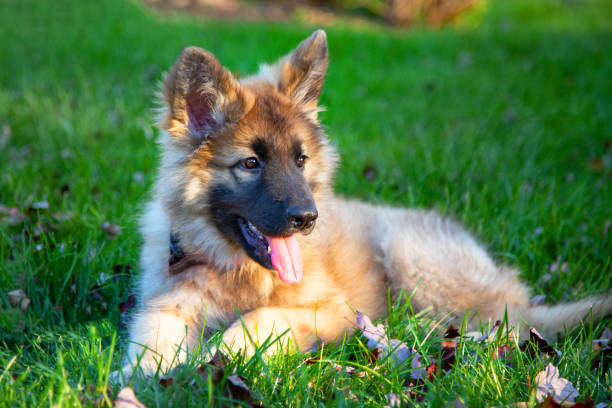Shiloh Shepherd

Breed History:
The Shiloh Shepherd is a modern American breed developed in the 1970s and 1980s by Tina Barber, a trainer and German Shepherd enthusiast. Dissatisfied with the declining health and temperament in show-line German Shepherds, she began a breeding program aimed at creating a larger, gentler, and more stable shepherd-type dog.
Shiloh Shepherds were developed from select German Shepherds, along with Alaskan Malamutes and other northern breeds, to produce a calmer, more family-friendly dog with a reduced risk of hip dysplasia and an athletic, yet proportionate, build. Although not recognised by the AKC, they are maintained through dedicated breed registries, such as the International Shiloh Shepherd Dog Club (ISSDC) and the Shiloh Shepherd Registry (SSR).
Considering adopting a German Shepherd or any of its variants? Check out our page "How to look after a German Shepherd" detailing what to consider before adopting and our recommended products for a GSD and its variants.
|
Gender |
Height |
Weight |
|
Male |
76-81 cm |
54-63 kg |
|
Female |
71-76 cm |
45-54 kg |
Size – Giant
Life Expectancy: 9–14 years

Breed Appearance:
The Shiloh Shepherd is a large, majestic dog with a confident, gentle demeanour. It resembles an oversized German Shepherd but has a broader chest, a more rectangular build, and a generally more substantial frame. Its movement is smooth and powerful, displaying both strength and grace.
The coat comes in two types: plush (long and thick) and smooth (shorter but still dense). Common coat colours include black and tan, sable, silver, grey, and bi-colour. It has a wolf-like expression, erect ears, and a bushy tail, which often hangs low when relaxed.
Breed Type – Companion/Working/Family:
Bred to be both intelligent and family-friendly, the Shiloh Shepherd is known for its calm temperament, gentle nature, and loyalty. While it retains some protective instincts, it is generally more easygoing and approachable than the standard German Shepherd.
This breed thrives as a companion animal, therapy dog, or service dog, but also retains the physical and mental ability to participate in activities like tracking, herding, and obedience competitions.

Training:
Shiloh Shepherds are highly intelligent and eager to learn. They respond well to positive reinforcement training and enjoy engaging with their owners. Their stable, eager-to-please temperament makes them excellent candidates for service dog work, search-and-rescue, and advanced obedience.
Early socialisation and consistent training are key to developing confidence and good manners, especially given their size and strength.
Health & Care:
Shiloh Shepherds were selectively bred to reduce common issues found in German Shepherds, particularly hip dysplasia. However, some health concerns still include:
-
Hip and elbow dysplasia
-
Degenerative myelopathy (DM)
-
Bloat (gastric torsion)
-
Panosteitis (in younger dogs)
Responsible breeders screen for these conditions. A balanced diet, joint supplements, and weight management are essential for long-term health.

Living Conditions:
The Shiloh Shepherd is best suited for homes with space, such as suburban or rural settings with a secure yard. It is not ideal for apartment living unless the owner is highly active and committed to daily exercise.
These dogs form deep bonds with their families and may develop separation anxiety if left alone for long periods. They do best in homes where they are actively included in daily life and receive ample mental stimulation.
Exercise:
Despite their calm indoor demeanour, Shiloh Shepherds need moderate to high daily exercise—ideally 60 to 90 minutes of structured activity. This can include long walks, obedience work, hiking, or dog sports.
Mental engagement is equally important. Without sufficient activity, they may become bored or anxious, leading to destructive behaviour.
Grooming:
Shiloh Shepherds have a double coat that requires regular brushing, 2–3 times per week for smooth-coated dogs and daily brushing for plush coats, especially during shedding seasons (spring and fall).
Bathing is needed occasionally. Routine nail trimming, ear cleaning, and dental care are part of essential grooming.

Advantages:
-
Calm, gentle, and affectionate temperament
-
Excellent with children and family members
-
Intelligent and responsive to training
-
Larger and generally healthier than standard GSDs
-
Versatile for therapy, service, and obedience work
-
Less intense prey and herding drive than many shepherds
Disadvantages:
-
Needs ample daily exercise and mental stimulation
-
Not ideal for small homes or sedentary owners
-
Prone to separation anxiety if left alone too long
-
Requires regular grooming, especially plush coats
-
Still at risk for some large-breed health issues
-
Limited availability and high initial cost from breeders

